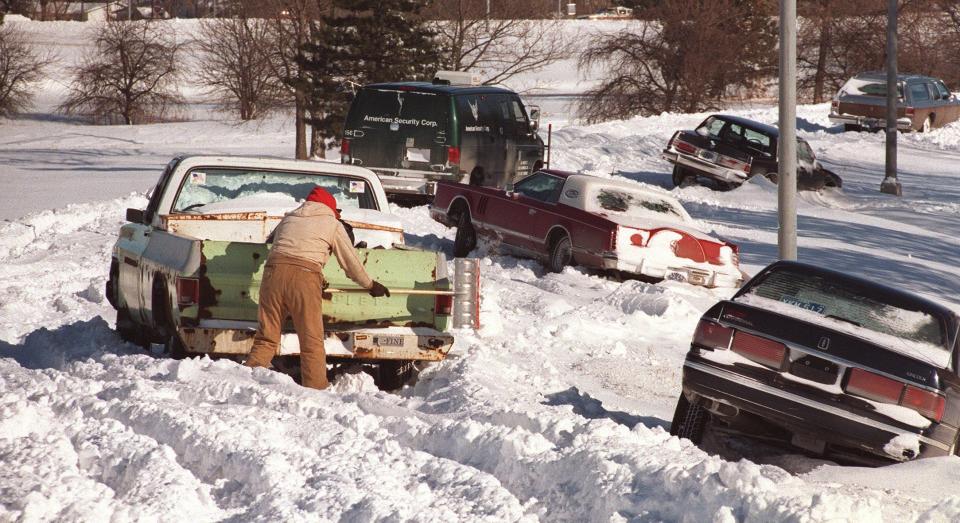Blizzards have been a hazard of Iowa life for a long time. Here's what to know about them

The National Weather Service is advising central Iowa residents to get ready for a potential blizzard later this week. Here's what to know about blizzards and how they've affected Iowa.
What is a blizzard?
It's tempting to label any heavy snowstorm a blizzard, but a blizzard specifically is a type of storm with not only snow but heavy winds over an extended period. According to the weather service, a blizzard has:
Sustained winds or frequent gusts of 35 mph or more, with snow and blowing snow.
Reduced visibility of a quarter mile or less for three or more hours.
What is a bomb cyclone?
The weather service and other forecasters use terms like bomb cyclone, explosive cyclogenesis and bombogenesis to describe an atmospheric phenomenon that can occur when a cold air mass slams into a warmer one, usually in northerly latitudes. If the resulting cyclone intensifies rapidly beyond a certain measure, it can turn an accompanying snowstorm into a raging blizzard. Forecasters used the term "bomb surface cyclogenesis" in describing the potential of this week's expected storm.
More:Days before Christmas, blizzard conditions could make travel 'impossible' in central Iowa
What kind of warnings accompany severe winter weather?
A blizzard warning is issued for an imminent storm meeting the criteria listed above. A ground blizzard warning is issued when the chief hazard is blowing or drifting snow.
Other severe winter weather alerts from the National Weather Service include:
Winter storm warning. Issued when "a significant combination of hazardous winter weather is occurring or imminent. Significant and hazardous winter weather is defined as a combination of: 1) 5 inches or more of snow/sleet within a 12-hour period or 7 inches or more of snow/sleet within a 24-hour period; 2) Enough ice accumulation to cause damage to trees or powerlines; and/or 3) a life threatening or damaging combination of snow and/or ice accumulation with wind."
Winter storm watch. Issued when there is a potential for, but not a certainty of, significant or hazardous winter weather within 48 hours.
Winter weather advisory. Issued "for any amount of freezing rain, or when 2 to 4 inches of snow (alone or in combination with sleet and freezing rain), is expected to cause a significant inconvenience, but not serious enough to warrant a warning."
More: How to check Iowa road conditions, DOT cameras amid winter weather
Historic blizzards in Iowa

Some historic Iowa blizzards include:
Jan. 12, 1888. The so-called Schoolchildren's Blizzard left 235 people dead across the northern Plains states. Among them were schoolchildren who, caught by the storm's sudden arrival and plunging temperatures, became lost in the hourslong whiteout that followed. Des Moines Register reports told of exposure deaths across the region, and of a teacher whose legs and arms had to be amputated after she suffered severe frostbite rescuing students caught in the storm. A railroad brakeman lost his hands after standing with a lantern in the blizzard to warn any approaching train that his own was on the tracks ahead, blocked by a snowdrift.
Nov. 11, 1940. The Armistice Day Blizzard came on what had been a mild day, with many people out and about amid temperatures in the mid-50s. Snowdrifts up to 20 feet high buried cars and severely hampered visibility, preventing would-be rescuers from reaching a military plane that crashed in Spirit Lake.
Jan. 2-5, 1949. Snow from the storm was so deep that planes were called in to deliver food and supplies to rural communities on impassable roads.
April 8-10, 1973. The worst spring blizzard the National Weather Service had ever recorded killed 14 people in Iowa and hundreds of farm animals. It also decimated populations of wild birds, which were migrating north when the freak storm struck.
Jan. 26, 1996. The storm that dumped almost 14 inches of snow on Des Moines began with thunderstorms that brought large hail and winds of more than 60 mph.
Dec. 19 and 20, 2012. A severe whiteout on Interstate 35 near Williams was blamed for a 25-vehicle pileup that left two people dead. Major roads across Iowa remained closed for days.
This article originally appeared on Des Moines Register: Iowa blizzards, bomb cyclones, and more about winter weather

